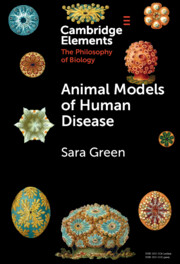Refine search
Actions for selected content:
92 results
Chapter 31 - Preclinical Models of Emotional Dysregulations in Animals
- from Section VII - Individual Differences
-
-
- Book:
- The Cambridge Handbook of Human Affective Neuroscience
- Published online:
- 16 September 2025
- Print publication:
- 02 October 2025, pp 618-638
-
- Chapter
- Export citation
Translational perspectives on women’s mental health
-
- Journal:
- The British Journal of Psychiatry / Volume 226 / Issue 6 / June 2025
- Published online by Cambridge University Press:
- 05 June 2025, pp. 331-333
- Print publication:
- June 2025
-
- Article
-
- You have access
- Open access
- HTML
- Export citation
Developing a potent vaccine against Helicobacter pylori: critical considerations and challenges
-
- Journal:
- Expert Reviews in Molecular Medicine / Volume 27 / 2025
- Published online by Cambridge University Press:
- 25 November 2024, e12
-
- Article
-
- You have access
- Open access
- HTML
- Export citation

Animal Models of Human Disease
-
- Published online:
- 17 April 2024
- Print publication:
- 16 May 2024
-
- Element
- Export citation
Skin Models Used to Define Mechanisms of Action of Sulfur Mustard
-
- Journal:
- Disaster Medicine and Public Health Preparedness / Volume 17 / 2023
- Published online by Cambridge University Press:
- 18 October 2023, e551
-
- Article
-
- You have access
- Open access
- HTML
- Export citation
The genetics of neuroticism: Insights from the Maudsley rat model and human studies
-
- Journal:
- Personality Neuroscience / Volume 6 / 2023
- Published online by Cambridge University Press:
- 04 August 2023, e6
-
- Article
-
- You have access
- Open access
- HTML
- Export citation
Painful dilemmas: the ethics of animal-based pain research
-
- Journal:
- Animal Welfare / Volume 18 / Issue 1 / February 2009
- Published online by Cambridge University Press:
- 01 January 2023, pp. 49-63
-
- Article
- Export citation
Animal Models in Neuropsychiatry: Do the Benefits Outweigh the Moral Costs?
-
- Journal:
- Cambridge Quarterly of Healthcare Ethics / Volume 31 / Issue 4 / October 2022
- Published online by Cambridge University Press:
- 18 November 2022, pp. 530-535
-
- Article
-
- You have access
- Open access
- HTML
- Export citation
Effects of Anesthetic Agents on Blood Brain Barrier Integrity: A Systematic Review
-
- Journal:
- Canadian Journal of Neurological Sciences / Volume 50 / Issue 6 / November 2023
- Published online by Cambridge University Press:
- 10 November 2022, pp. 897-904
-
- Article
-
- You have access
- HTML
- Export citation
Effects of selenium supplementation on glycaemic control markers in healthy rodents: a systematic review and meta-analysis
-
- Journal:
- British Journal of Nutrition / Volume 130 / Issue 4 / 28 August 2023
- Published online by Cambridge University Press:
- 21 October 2022, pp. 564-574
- Print publication:
- 28 August 2023
-
- Article
-
- You have access
- HTML
- Export citation
Variables influencing conditioning-evoked hallucinations: overview and future applications
-
- Journal:
- Psychological Medicine / Volume 52 / Issue 14 / October 2022
- Published online by Cambridge University Press:
- 23 September 2022, pp. 2937-2949
-
- Article
-
- You have access
- Open access
- HTML
- Export citation
7 - Role of Animal Models in Alzheimer’s Disease Drug Development
- from Section 2 - Non-clinical Assessment of Alzheimer’s Disease Candidate Drugs
-
-
- Book:
- Alzheimer's Disease Drug Development
- Published online:
- 03 March 2022
- Print publication:
- 31 March 2022, pp 73-94
-
- Chapter
- Export citation
8 - Nanomedicine Drug Dosing
-
- Book:
- Fundamentals of Nanomedicine
- Published online:
- 08 March 2022
- Print publication:
- 31 March 2022, pp 143-158
-
- Chapter
- Export citation
9 - Preclinical Longitudinal In Vivo Biomarker Platform for Alzheimer’s Disease Drug Discovery
- from Section 2 - Non-clinical Assessment of Alzheimer’s Disease Candidate Drugs
-
-
- Book:
- Alzheimer's Disease Drug Development
- Published online:
- 03 March 2022
- Print publication:
- 31 March 2022, pp 106-122
-
- Chapter
- Export citation
Current status of experimental models for the study of malaria
-
- Journal:
- Parasitology / Volume 149 / Issue 6 / May 2022
- Published online by Cambridge University Press:
- 21 February 2022, pp. 729-750
-
- Article
-
- You have access
- Open access
- HTML
- Export citation
Chapter 10 - Examining the Safety of ICSI Using Animal Models
-
-
- Book:
- Manual of Intracytoplasmic Sperm Injection in Human Assisted Reproduction
- Published online:
- 02 December 2021
- Print publication:
- 25 November 2021, pp 95-102
-
- Chapter
- Export citation
Rodent models of metabolic disorders: considerations for use in studies of neonatal programming
-
- Journal:
- British Journal of Nutrition / Volume 128 / Issue 5 / 14 September 2022
- Published online by Cambridge University Press:
- 23 September 2021, pp. 802-827
- Print publication:
- 14 September 2022
-
- Article
-
- You have access
- HTML
- Export citation
7 - Nurture and Nature
-
-
- Book:
- The Science of Violent Behavior Development and Prevention
- Published online:
- 28 January 2021
- Print publication:
- 18 February 2021, pp 155-187
-
- Chapter
- Export citation
Exploring test batteries for depression- and anxiety-like behaviours in female and male ICR and black Swiss mice
-
- Journal:
- Acta Neuropsychiatrica / Volume 32 / Issue 6 / December 2020
- Published online by Cambridge University Press:
- 07 May 2020, pp. 293-302
-
- Article
- Export citation
